In 2012, polling by Latino Decisions found that Mitt Romney won the support of just 23 percent of Latino voters. In 2016, the Republican presidential candidate will need twice that support to win the White House.
The cause for the GOP’s “Latino deficit” is no secret and can largely be explained by two interrelated factors: Latinos are the growth segment of the electorate and just one Republican presidential candidate in the last six elections has won a majority of the popular vote.
To assess how these dynamics may play out in 2016, we use data from recent presidential elections to model the sizes of the Latino and Non-Latino segments of the electorate and these groups’ contribution to the GOP aggregate vote.
Specifically, we average the U.S. Census P20 Reports and Exit Polls estimates to predict the Latino and Non-Latino shares of the electorate. Multiplying these groups’ Republican support as reported by the Exit Polls (all years), Latino Decisions (2008 and 2012), and Ruy Teixeira (2004) by the groups’ shares of the electorate generates the Latino and Non-Latino contribution to the GOP vote.
The table below uses the 2000-2012 presidential elections to demonstrate the model.

For the series, Republican presidential candidates averaged just over 47 percent of the popular vote. Except for 2008, Non-Latino support for Republican presidential candidates has hovered around fifty percent; a quantity that has brought the party diminishing returns as that segment of the electorate has shrunk. Conversely, as the Latino share of the electorate has grown, the Latino contribution to the GOP vote has remained more-or-less constant, ranging between two and two and a half points. The high-water mark of 3.09 uses the highly disputed 2004 Exit Poll estimates of Latino Republican support. Reanalysis by Teixeira and others suggests that Bush’s 2004 support among Latinos was 39 percent; a four point improvement over 2000.
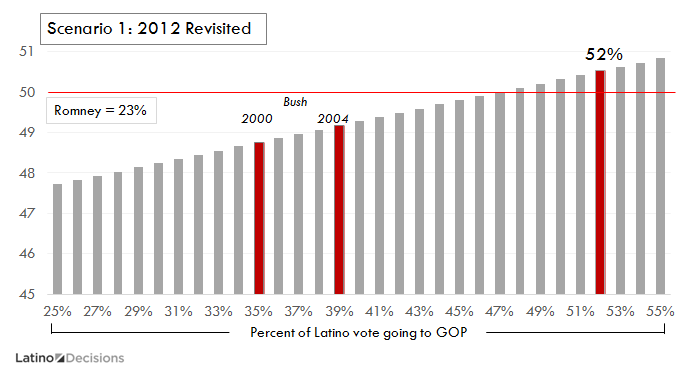
The figures presented below use the model to make projections about the Latino and Non-Latino contributions to the 2016 Republican presidential vote under a number of scenarios. Under Scenario 1, Latino support for the GOP is varied, while the Non-Latino share of the electorate performs as in 2012. This represents a worst-case scenario for the Republicans as it recreates the voting behavior that facilitated President Obama’s reelection, while also increasing the size of the Latino electorate by 1.19 points. If this were to occur, then the Republican presidential candidate would need 52 percent of the Latino vote to win a majority of the popular vote.
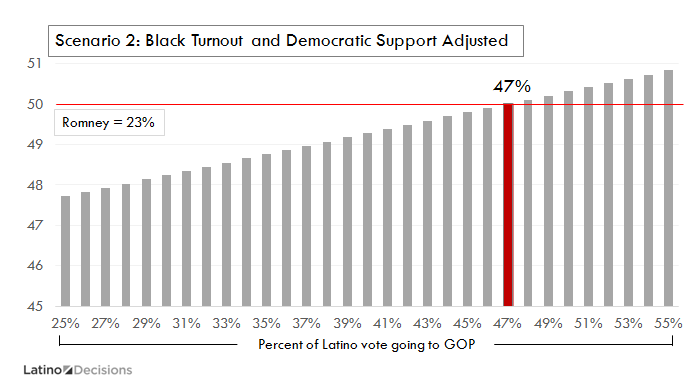
There is reason to think that some voters may behave differently in 2016 as compared to 2012. Most notably, in both 2008 and 2012 black turnout and Democratic support exceeded historical norms. To account for this, Scenario 2 adjusts our projections to control for the “Obama bump” in black turnout and support. This increases the Non-Latino contribution to the GOP vote by just over half a point and slightly increases the size of the Latino share of the electorate. If this were to occur, then the GOP would need the votes of 47 percent of Latinos to win a majority of the popular vote.

Scenario 3 assumes that white voters consolidate behind the Republican Party at levels that were observed in 2014; that black participation and Democratic support returns to pre-Obama levels; and the expected growth in the Latino vote does not fully materialize. Under these conditions, which can be thought of as a best-case scenario for the GOP, the party’s Latino threshold would be 42 percent.
Of course, presidents are not elected nationally, but rather by the states; arrangements that allow the presidency to be won by candidates who lose the popular vote as George W. Bush did in 2000. To assess the GOP’s Latino threshold in some of the swing states, we apply the Scenario Two estimation to four swing states with large Latino electorates and two with emerging Latino electorates.
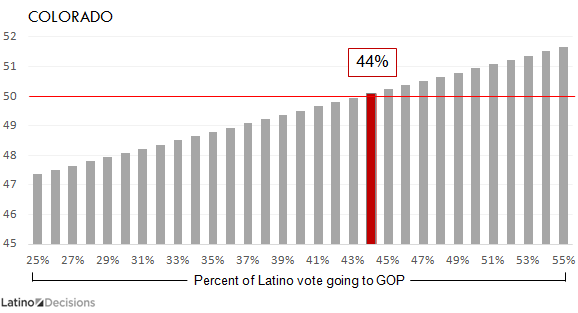
To be clear, the data used for the state projections are not as comprehensive as for the national forecasts and these estimates do not account for the vagaries of state political environments, such as outsized support for minor party candidates or Nevada’s “none of the above option,” which allow candidates to secure a state’s Electoral College votes with plurality support.
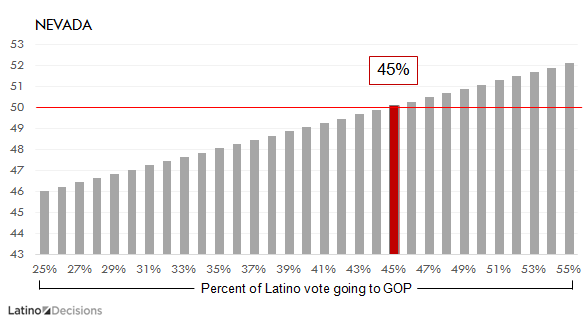
Consistent with the national estimates, the state projections indicate the uphill battle that GOP presidential candidates face in the swing states.
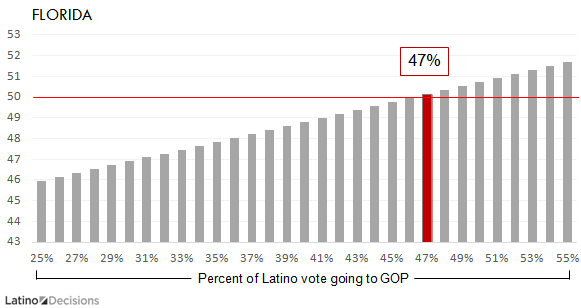
In the four Latino heavy states (Colorado, Florida, New Mexico, and Nevada) the threshold varies from 42 percent in New Mexico to 47 percent in Florida, while in Ohio it is 43 percent and 46 percent in Virginia.
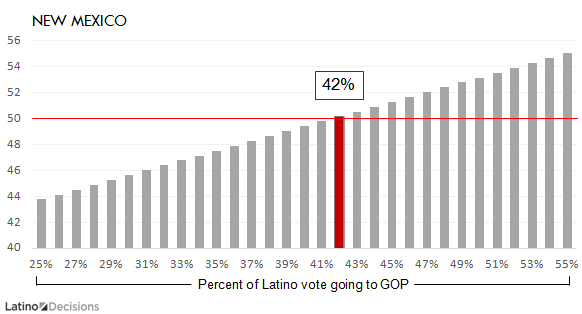
Note the truncated y-axis for Ohio and Virginia; a consequence of these states’ relatively small shares of Latino voters.

It is also in these states where the adjustments for black turnout and Democratic support have the biggest effect, increasing the GOP Non-Latino contribution by 1.70 points in Ohio and 1.19 in Virginia.
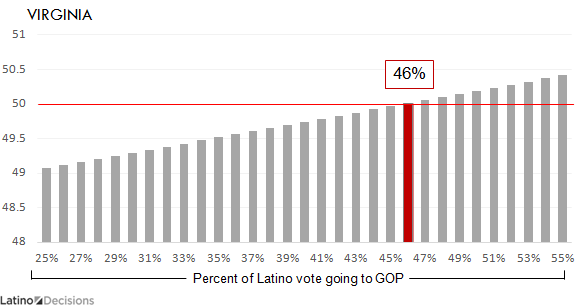
The analysis presented here underscores a number of important points.
First, the conventional wisdom often asserted by pundits and in media reports that winning 40 percent of the Latino vote will be sufficient for the Republicans to carry the presidency in 2016 is farcical. The 40 percent threshold assumes that the Bush-Kerry demographics of 2004 are still in effect even though that election was 12 years ago.
Second, when our model is applied to the key battleground states that will decide the 2016 election, the Latino threshold for the Republican presidential candidate varies from 42 to 47 percent; levels that are similar to Scenarios 2 and 3 for the national model.
Third, because our model is easy to calculate, it can be adjusted to account for a range of possible 2016 scenarios. It can also be updated as reliable state and national polling data is reported in the coming months. For instance, if minor party candidates are able to gain traction and siphon support from the Democratic or Republican nominee in specific states or nationally, our model can account for this, as well as any marginal changes in the preferences of different voting groups.
Fourth, except for Scenario 3, our model assumes that the Latino electorate will grow at rates observed in prior elections. Yet, as 2014 demonstrates, Latino political participation cannot be taken for granted as many Latinos continue to feel alienated from the political process, particularly in light of the political system’s failure to deliver comprehensive immigration reform. Moreover, even in presidential elections, Latino registration and turnout lags behind population share. Mobilizing and enlarging the Latino electorate is particularly acute for Democrats. Indeed, it is because of the overwhelming support of Latino voters that the Democrats are better positioned in many of the swing states needed to cobble together the 270 Electoral College necessary for the presidency.
More generally, our model accentuates the tension between the Republican Party’s long-term viability and the short-term goals of the party’s presidential aspirants. Sensing that the party’s Latino deficit is too large or that any moderation on immigration may undermine their ability to win the nomination, a number of candidates have already tacked to the right on immigration. Others have been unwilling to criticize the most strident anti-immigrant voices emanating from the field. Indeed, only long-shot candidate Senator Lindsey Graham seems to grasp the damage that the party’s latest fount of an anti-immigrant sentiment, Donald Trump, is inflicting on the party’s prospects in 2016 and beyond. Meanwhile, just one Republican, Ben Carson, spoke at last month’s Annual Meeting of the National Association of Latino Elected and Appointed Officials (NALEO), and at her association’s meeting, Janet Murguía, the head of the National Council of La Raza, went so far as to call out the Republican Party for its failure to repudiate Trump’s comments.
Nearly four years later, the Republican Party appears to look a lot like the party described in the Republican National Committee’s “Growth and Opportunity Project” report. You know, the report that found that “Hispanic voters tell us our Party’s position on immigration has become a litmus test, measuring whether we are meeting them with a welcome mat or a closed door.” Meanwhile, a 40 percent threshold becomes a 47 percent threshold and every month over 50,000 Latinos celebrate their 18th birthdays.
David Damore is a Senior Analyst at Latino Decisions and Associate Professor of Political Science at the University of Nevada, Las Vegas.
Matt A. Barreto is co-founder of Latino Decisions and Professor of Political Science and Chicano/a Studies at UCLA.

